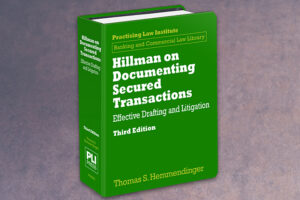
Image courtesy of PLI.
The newest edition of Hillman on Documenting Secured Transactions: Effective Drafting and Litigation, recently published by PLI Press, updates an authoritative treatise with best practices from a 21st-century perspective. Designed as a useful, accessible resource, the book covers significant amendments made in 2022 to the Uniform Commercial Code (UCC) designed to accommodate emerging technologies. We spoke with author Thomas S. Hemmendinger, of Brennan, Recupero, Cascione, Scungio & McAllister, LLP in Providence, Rhode Island.
What makes this book a useful resource for lawyers working today?
Since the book compiles and organizes relevant case law from all jurisdictions, lawyers get a jump start in developing and supporting the legal arguments they’ll need in court to enforce security interests. The book puts more than 60 years of UCC Article 9 jurisprudence in context, so lawyers can tell which case law is still useful in interpreting the latest version of Article 9.
This book also provides both the legal framework and practical guidance on how to document a secured transaction today in a way that capitalizes on the benefits that secured lenders will get when the 2022 UCC technology amendments become law.
Your treatise is one of the first on the market to address the extensive 2022 amendments to the UCC. What was your involvement in drafting these amendments? How did you become interested in the topic?
In 2018, the Uniform Law Commission (ULC) and the American Law Institute (ALI), who are the UCC’s co-sponsors, began a comprehensive study and drafting project to accommodate emerging technologies. As a member of the ULC, I was privileged to serve on the study and drafting committees. In 2022, both the ULC and ALI approved our proposed amendments.
My interest in the Code began in 1982 when Bill Hillman, the original author of this book, hired me as a law clerk. After law school, I joined Bill’s law firm as an associate and later became a partner. Throughout my career, most of my work has involved the Code in some manner, especially commercial loan transactions and workouts, receiverships, and bankruptcies.
What are some highlights of the 2022 amendments practitioners should be familiar with?
The 2022 amendments affect nearly every article of the Code, but those with the biggest effect on secured transactions include:
- A new Article 12 on controllable electronic records (CERs), including most “digital assets.” The Code already covers CERs as general intangibles. However, Article 12 creates a new regime for perfecting a security interest in a CER through control, making CERs much more readily transferrable and financeable, because someone who perfects a security interest in a CER by control has priority over security interests perfected through other means, such as the filing of a financing statement.
- A purchaser (including a secured party) who acquires a CER in good faith, for value, and without notice of a property claim to the CER actually takes the CER free of that claim. This makes a CER that evidences a right to payment (a “controllable payment intangible” under the amendments) the functional equivalent of a negotiable electronic promissory note.
- The CER concept can also be applied to accounts receivable. A “controllable account” is an account where the customer agrees to pay whoever is in control of the CER that evidences the account.
- Obligor-friendly rules on who is entitled to payment on one of these digital assets when control is transferred.
- CERs are designed to handle not only the latest technology, but also any future technologies. Before the 2022 amendments, the law assumed that a digital asset exists only as a single, unique original thing, whereas many digital assets reside in systems that use distributed ledger technologies, such as a blockchain, where multiple originals may exist.
- These innovative concepts have been adapted to chattel paper (payment obligations secured by specific goods) and documents of title (bills of lading and warehouse receipts).
- Many conforming changes to ensure that the CER-related changes dovetail into Article 9’s existing rules.
- Finally, the cleansing of outdated Code requirements for paper documents where an electronic document will work in practice.
What are some risks practitioners should be aware of when documenting secured transactions?
Some of the most common mistakes include not understanding what Article 9 does and does not cover, thereby failing to comply with the right set of laws, as well as failing to: properly describe the collateral in the security agreement or in the UCC-1 financing statement; use the correct debtor name on the UCC-1 financing statement; or appreciate the need for, and how to draft, intercreditor or subordination agreements, when multiple parties have an interest in the collateral. Each of these could result in the partial or complete loss of the client’s collateral. The book gives sensible guidance on how to avoid these mistakes.